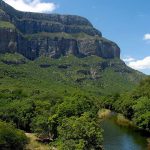
In the week when farmer association KwaNalu reported that there were thousands of oil and gas exploration applications to prospect on KwaZulu-Natal farmland (Farmer’s Weekly 23 Sept 2016), a group of journalists and team assembled by the WWF Nedbank Green Trust were looking at how the possibility of a tungsten mine spurred a group of farmers to have their area classified as a Protected Environment.
Most people enjoy a break from the routine, especially if it involves travel. When the invitation came from the WWF Nedbank Green Trust to accompany a contingent of journalists and others to the West Coast, I put my hand up and the morning of the 21st September found me in one of two silver Hyundai buses pointing north from Cape Town.
The reader will appreciate that names like Moorreesburg, Piketburg and the Sandveld in the Western Cape have long been linked to agriculture, and during our years of compiling the agricultural publication those names have become very familiar: a group of farmers started the co-operative called Moorreesburg Koring Boere (Moorreesburg Wheat Farmers), now part of a larger agribusiness; the Sandveld is renowned for its potatoes and the conservation efforts that go with protecting its ecosystem; agricultural training providers Praktika are based in Piketberg … The notice of proposed mining activity in Moutonshoek, just north of Piketberg, was enough to get landowners of the area together. The alarm bells were heard in wider conservation circles and led to the involvement of Birdlife South Africa and the Wildlife and Environment Society of South Africa (WESSA), backed by the WWF Nedbank Green Trust.
Moutonshoek is the catchment area supplying the Krom Antonies River, which widens through wetlands, leading to the estuary at Elandsbaai on the West Coast. The wetlands are a Ramsar proclaimed site, and an Important Bird and Biodiversity Area (IBA) too, with significant populations of threatened and migratory bird species included amongst the 200 plus bird species it hosts. Also to be counted in the biodiversity of the area are the IUCN Red-listed Verlorenvlei Redfin fish (Pseudobarbus verloreni), the Endangered Diascia caitliniae, and the Critically Endangered Redlinghuys Pincushion (Leucospermum arenarium), and looking on from the mountains, the Cape Leopard. Add to this biodiversity the population of Elandsbaai, very dependent on the single aquifer under Moutonshoek and the reader will appreciate what brought farmers, conservationists and others together.
If land is as vital as the Mountonshoek-Verlorenvlei area, then there is a need to gear up from a simple conservancy to something with a bit more clout. (To see what the Biodiversity Stewardship options are, refer to heading 5 of the “Biodiversity and ecosystems services” chapter of the Agri Handbook or click here). After consultations, the farmers in Moutonshoek decided to go for Protected Environment status and signed a Memorandum of Understanding with Cape Nature, the provincial nature agency, to declare the intention to pursue the Biodiversity Stewardship model for the area.



Share this article







